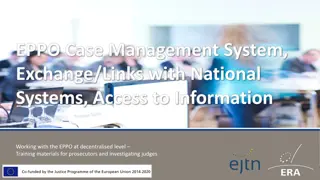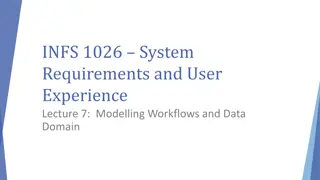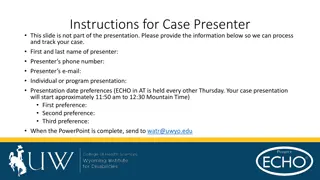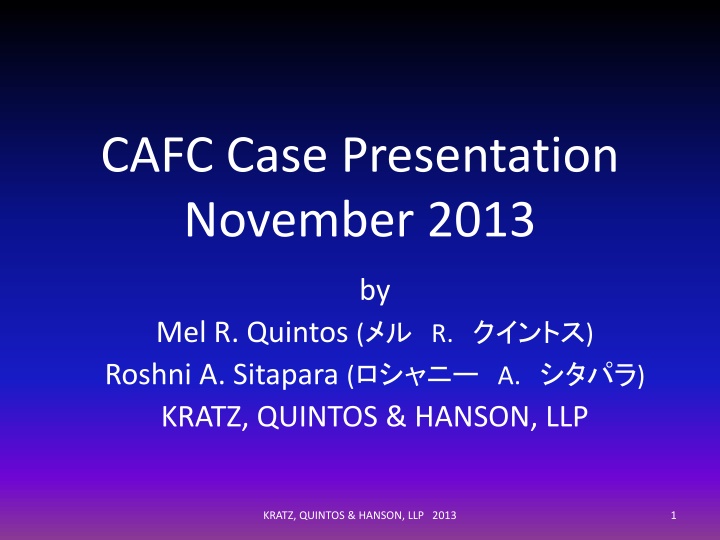
Avoiding Claim Language Limitations in Patent Cases
This presentation covers various patent cases before the U.S. Court of Appeals for the Federal Circuit, highlighting strategies to avoid claim language that may restrict the scope of inventions. Cases include Alexsam, Inc. v. IDT Corporation, Creative Integrated Systems, Inc. v. Nintendo of America, Inc., Ultramercial, Inc. v. Hulu, LLC, and more. Learn about overcoming references, differentiating embodiments in complex technologies, and determining patentable subject matter in the Information Age.
Download Presentation

Please find below an Image/Link to download the presentation.
The content on the website is provided AS IS for your information and personal use only. It may not be sold, licensed, or shared on other websites without obtaining consent from the author. If you encounter any issues during the download, it is possible that the publisher has removed the file from their server.
You are allowed to download the files provided on this website for personal or commercial use, subject to the condition that they are used lawfully. All files are the property of their respective owners.
The content on the website is provided AS IS for your information and personal use only. It may not be sold, licensed, or shared on other websites without obtaining consent from the author.
E N D
Presentation Transcript
CAFC Case Presentation November 2013 by Mel R. Quintos ( R. ) Roshni A. Sitapara ( A. ) KRATZ, QUINTOS & HANSON, LLP KRATZ, QUINTOS & HANSON, LLP 2013 1
1. ALEXSAM, INC. v. IDT CORPORATION This case shows how to avoid claim language that may limit the scope of a claimed invention within a specific time period. CAFC 2. CREATIVE INTEGRATED SYSTEMS, INC. v. NINTENDO OF AMERICA, INC. In complex circuit technology, each embodiment should have its own separate set of description, claims, drawings and arguments. CAFC KRATZ, QUINTOS & HANSON, LLP 2013 2
3. ULTRAMERCIAL, INC. v. HULU, LLC The Court of Appeals for the Federal Circuit provides a test to determine whether a claimed invention directed to the Information Age or to Technology without anchors in physical structures and mechanical steps (for example, software) may be patentable subject matter under 35 U.S.C. 101. CAFC 101 Information Age 4. IN RE JOSEPH GIUFFRIDA This case shows how to overcome a reference that, according to the U.S. PTO, inherently discloses the claimed limitation. CAFC USPTO KRATZ, QUINTOS & HANSON, LLP 2013 3
ALEXSAM, INC. v. IDT CORPORATION Decided: May 20, 2013 KRATZ, QUINTOS & HANSON, LLP 2013 4
U.S. PATENT NO. 6,000,608 ALEXSAM, INC. is patent owner ALEXSAM, INC. sued IDT CORPORATION for infringement District Court: (1) ALEXSAM INC. s patent is valid (2) IDT CORPORATION s systems infringed patent (3) Damage was about $ 8,700,000 IDT CORPORATION appealed to the U.S. Court of Appeals for the Federal Circuit (CAFC) ALEXSAM, INC.v. IDT CORPORATION KRATZ, QUINTOS & HANSON, LLP 2013 5
Independent Claim 57 and Dependent Claim 58 A system for reading and activating multi-function cards (for example, prepaid phone cards, and electronic gift certificates) Critical claimed limitations: (1) the card s number includes a bank identification number ( BIN ); and (2) the activation of the card is performed by an unmodified existing standard retail point-of-sale [POS] device ALEXSAM, INC.v. IDT CORPORATION KRATZ, QUINTOS & HANSON, LLP 2013 6
Both parties agreed that an unmodified existing standard retail point- of-sale [POS] device (specifically recited in the claim) is: a terminal for making purchases at a retail location of the type in use as of July 10, 1997that has not been reprogrammed, customized, or otherwise altered with respect to its software or hardware for use in the card system. To meet its burden of proof on infringement of claims 57 and 58, ALEXSAM, INC. must prove: (1)the systems that read the cards used terminals of the type in use as of July 10, 1997, and (2)those terminals ha[d] not been reprogrammed, customized, or otherwise altered with respect to its software or hardware for use in the card system. ALEXSAM, INC.v. IDT CORPORATION KRATZ, QUINTOS & HANSON, LLP 2013 7
ALEXSAM, INC. had two expert witnesses. 1st Witness: (1)No opinion on whether IDT CORPORATION s actual POS terminals had been reproduced, customized, or otherwise altered in any way. (2)Admitted that he was not an expert on terminals that read and activated the cards. 2nd Witness: (1)Did not know for sure whether modifications have, in fact, been made for any reason to the IDT CORPORATION s terminals. (2)Admitted that he was not an expert on the specific feature functionality of the various terminals. ALEXSAM, INC.v. IDT CORPORATION KRATZ, QUINTOS & HANSON, LLP 2013 8
CAFC Decision: (1)ALEXSAM, INC. did not meet its burden of proof because it failed to present substantial evidence that IDT CORPORATION s systems had not been reprogrammed, customized, or otherwise altered with respect to [their] software . . . for use in the card system. (2)REVERSED NO INFRINGEMENT by IDT CORPORATION ALEXSAM, INC.v. IDT CORPORATION KRATZ, QUINTOS & HANSON, LLP 2013 9
LESSONS: (1)For systems that rely on software, do NOT limit the claim language to unmodified or unaltered device. (2)The claimed unmodified or unaltered device is limited to a device that is in use during a specific time period; thus, an alleged infringer can easily reprogram, customize or alter the software to avoid infringement. (3)In this case, the claimed card reader was an unmodified existing standard retail POS device, which was limited to a device of the type in use as of July 10, 1997. (4)Also, it will be difficult for the patent owner to prove that the alleged infringing device is unmodified or unaltered. ALEXSAM, INC.v. IDT CORPORATION KRATZ, QUINTOS & HANSON, LLP 2013 10
CREATIVE INTEGRATED SYSTEMS, INC. v. NINTENDO OF AMERICA, INC. Decided: June 3, 2013 KRATZ, QUINTOS & HANSON, LLP 2013 11
U.S. PATENT NO. 5,241,497 CREATIVE INTEGRATED SYSTEMS, INC. is patent owner CREATIVE INTEGRATED SYSTEMS, INC. sued NINTENDO OF AMERICA, INC. After a Markman hearing, where the claim language is interpreted, the District Court found that NINTENDO did not infringe CREATIVE s improved ROM (read only memory) device. CREATIVE INTEGRATED SYSTEMS, INC. appealed to the CAFC CREATIVE INTEGRATED SYSTEMS, INC.v. NINTENDO OF AMERICA, INC. KRATZ, QUINTOS & HANSON, LLP 2013 12
CREATIVE INTEGRATED SYSTEMS, INC.v. NINTENDO OF AMERICA, INC. KRATZ, QUINTOS & HANSON, LLP 2013 13
U.S. Patent No. 5,241,497 relates to a read only memory (ROM), and in particular to improvements in the circuitry and methodology of the subcircuits included within a very large integrated (VLSI) ROM. Three lines connect the cell blocks (77) to one another with the following: (1) a ground line(VG0), (2) a ground line (VG1), and (3) one main bit line (BL0) All three lines are metallization lines (made of metal) CREATIVE INTEGRATED SYSTEMS, INC.v. NINTENDO OF AMERICA, INC. KRATZ, QUINTOS & HANSON, LLP 2013 14
Figure 7 Non-Infringement Figure 9 Infringement CREATIVE INTEGRATED SYSTEMS, INC.v. NINTENDO OF AMERICA, INC. KRATZ, QUINTOS & HANSON, LLP 2013 15
Claim 12 states that the plurality of blocks [are] coupled together at their ends by metallization lines. District Court: (1) Based on ordinary and customary reading of the claim language, in claim 12: (a) the cell blocks are coupled together by metallization lines. (b) There is no mention of the lines connecting to both ends of each block, or to any end of each block. (c) Therefore, claim 12 covers both embodiments, Figure 7 and Figure 9; and NINTENDO OF AMERICA, INC. infringes. CREATIVE INTEGRATED SYSTEMS, INC.v. NINTENDO OF AMERICA, INC. KRATZ, QUINTOS & HANSON, LLP 2013 16
(2) Based on the specification: (a) The invention has a plurality of contacts connected to the virtual ground lines and the main bit line at the end of each block. (b)The virtual ground lines and main bit line have a contact connected therewith at opposing ends of each block of memory cells. (c) Therefore, claim 12 is limited to only Figure 7; and therefore, no infringement. (3) Based on the prosecution history, the district court relied on a single sentence where the patentee had argued the cell blocks could be accessed from either end; and therefore, claim 12 is limited to only Figure 7, and there is no infringement. CREATIVE INTEGRATED SYSTEMS, INC.v. NINTENDO OF AMERICA, INC. KRATZ, QUINTOS & HANSON, LLP 2013 17
CAFC Decision: The CAFC agrees with the District Court s analysis based on the ordinary and customary reading of the language of claim 12; and the District Court could have ended its analysis with the plain language analysis. The District Court was wrong in its interpretation of claim 12 based on the specification and the prosecution history. The specification and drawings in this case describe over a dozen improvements to various components of ROM circuitry * * * described by the figure 7 and figure 9 embodiments. CREATIVE INTEGRATED SYSTEMS, INC.v. NINTENDO OF AMERICA, INC. KRATZ, QUINTOS & HANSON, LLP 2013 18
During the prosecution history, there were some amendments and arguments directed to claim limitations requiring only that the metallization lines connect one block to the next, and some that clearly expressed that each end of an individual block is connected to the other. Therefore, claim 12 covers both the embodiments of Figure 7 and Figure 9; and NINTENDO OF AMERICA, INC. infringes. CREATIVE INTEGRATED SYSTEMS, INC.v. NINTENDO OF AMERICA, INC. KRATZ, QUINTOS & HANSON, LLP 2013 19
LESSONS: In complex circuits: (1)Each embodiment described in the specification should be illustrated with its corresponding drawing or set of drawings. (2)Each embodiment should be covered by its own claim or its own set of claims. (3)During prosecution history, each embodiment should have its own set of claim amendments and arguments. CREATIVE INTEGRATED SYSTEMS, INC.v. NINTENDO OF AMERICA, INC. KRATZ, QUINTOS & HANSON, LLP 2013 20
ULTRAMERCIAL, INC. v. HULU, LLC Decided: June 21, 2013 KRATZ, QUINTOS & HANSON, LLP 2013 21
U.S. Patent No. 7,346,545 ULTRAMERCIAL, INC. is patent owner ULTRAMERCIAL, INC. sued HULU, LLC for infringement District Court: (1) ULTRAMERCIAL, INC. s patent is invalid for being non-patentable subject matter under 35 U.S.C. 101 (2) The CAFC had previously reversed and remanded, but the earlier decision was vacated by the U.S. Supreme Court, and the case had returned to the CAFC ULTRAMERCIAL, INC. v. HULU, LLC KRATZ, QUINTOS & HANSON, LLP 2013 22
Independent Claim 1 No structure or hardware is recited in the claim A method for distribution of products over the Internet via a facilitator which includes: a fifth step of offering to a consumer access to the media product without charge to the consumer on the precondition that the consumer views the sponsor message. facilitator is a person, not hardware ULTRAMERCIAL, INC. v. HULU, LLC KRATZ, QUINTOS & HANSON, LLP 2013 23
CAFC Analysis: abstract ideas are not patentable subject matter under 35 U.S.C. 101 A claim to a process is patentable subject matter if: (1) it is implemented with a particular machine specifically devised and adapted to carry out the process, or (2) it transforms an article from one thing or state to another (so-called machine or transformation test). machine or transformation test is inadequate The above test is inadequate for the Information Age and for Technology without anchors in physical structures and mechanical steps. ULTRAMERCIAL, INC. v. HULU, LLC KRATZ, QUINTOS & HANSON, LLP 2013 24
CAFC Analysis (Continued): TEST: The question for patent eligibility is whether the claim contains limitations that meaningfully tie that abstract idea to an actual application of that idea through meaningful limitations. This inquiry focuses on whether the claims tie the otherwise abstract idea to a specific way of doing something with a computer, or specific computer for doing something; if so, they will likely be patent eligible. ULTRAMERCIAL, INC. v. HULU, LLC KRATZ, QUINTOS & HANSON, LLP 2013 25
Figure 1 Figure 2 ULTRAMERCIAL, INC. v. HULU, LLC KRATZ, QUINTOS & HANSON, LLP 2013 26
CAFC Decision: The claimed invention requires complex computer programming and cites Figure 1, which shows several interconnected computers, and its Figure 2, a flowchart which is tied to computer implementation. The claimed invention is thus patentable subject matter under 35 U.S.C. 101. ULTRAMERCIAL, INC. v. HULU, LLC KRATZ, QUINTOS & HANSON, LLP 2013 27
LESSONS: Processes that are linked with computers or the Internet: (1)should be claimed with claims reciting many steps, (2)should imply a high level of programming complexity, and (3)should be linked to complex drawings showing several computer systems. ULTRAMERCIAL, INC. v. HULU, LLC KRATZ, QUINTOS & HANSON, LLP 2013 28
IN RE JOSEPH GIUFFRIDA Decided: July 18, 2013 KRATZ, QUINTOS & HANSON, LLP 2013 29
U.S. PATENT APPLICATION NO. 11/432,583 JOSEPH GIUFFRIDA is patent application owner All Claims were rejected by Examiner IN RE JOSEPH GIUFFRIDA KRATZ, QUINTOS & HANSON, LLP 2013 30
U.S. PTO Board of Patent Appeals and Interferences (now the Patent Trial and Appeal Board): (1)Sustained the rejections, except for dependent claim 22 (2)Independent claims 1, 15 and 21 (3)Certain claims remain rejected as being anticipated by the prior art reference under 35 U.S.C. 102 because the prior art reference inherently discloses the claimed invention. (4)The Board found that the prior art reference anticipates claims 2 and 16, and then used that anticipation rejection as the reason for an obviousness rejection of claims 7 and 20. (5)Claims 2 and 16 depend on independent claims 1 and 15, respectively. (6)Both sides agree that the obviousness rejections of claims 7 and 20 fall if the anticipation rejections of claims 2 and 16 fall. IN RE JOSEPH GIUFFRIDA KRATZ, QUINTOS & HANSON, LLP 2013 31
JOSEPH GIUFFRIDA appealed to the CAFC. IN RE JOSEPH GIUFFRIDA KRATZ, QUINTOS & HANSON, LLP 2013 32
Representative Claim 1: movement disorder comprising[:] A portabletherapy system for rehabilitation of a subject s having a signal related to the muscle s electrical activity; and a sensor for measuring a subject s voluntary muscle activity stimulus to the subject to respond to a device for providing a video, audio, written or verbal calculated based in part on the signal for measuring the subject s electrical muscle activity. wherein the subject s ability to respond to the stimulus is IN RE JOSEPH GIUFFRIDA KRATZ, QUINTOS & HANSON, LLP 2013 33
Giuffridas Figure Prior Art Figure IN RE JOSEPH GIUFFRIDA KRATZ, QUINTOS & HANSON, LLP 2013 34
CAFC Analysis: The issue is whether the prior art reference anticipates the claims because it discloses, either expressly or inherently, the limitation requiring that Giuffrida s device be portable. An anticipating reference must disclose every claim limitation, either expressly or inherently. Inherent disclosure requires that the prior-art reference necessarily include the unstated limitation. Probabilities or possibilities are not enough to find that the prior art inherentlydiscloses something not explicitly present. IN RE JOSEPH GIUFFRIDA. KRATZ, QUINTOS & HANSON, LLP 2013 35
The Board itself observed that the prior art reference does not expressly state that [its] system is portable or can be carried. The Board found that the prior art reference inherently discloses a portable system because the prior art reference does not appear to contain any structure confining it to a particular location. (1)The Board s observation does not indicate that the prior art reference must necessarily be free from confinement to a particular location. (2)The Board implies that the prior art reference does not say that its system is not portable. But this is just repeating the fact that the prior art reference does not expressly disclose the portable system. (3)The prior art reference does not inherently disclose anything to permit the burden of proof to shift to the applicant. IN RE JOSEPH GIUFFRIDA. KRATZ, QUINTOS & HANSON, LLP 2013 36
CAFC Decision: (1)The claims must be given their broadest reasonable construction in light of the specification as it would be interpreted by one of ordinary skill in the art. (2)In this case, Giuffrida s specification states that, to be portable, the system must be capable of being transported relatively easily. (3)REVERSED NO ANTICIPATION REJECTION IN RE JOSEPH GIUFFRIDA. KRATZ, QUINTOS & HANSON, LLP 2013 37
LESSONS: (1) Be consistent throughout the specification in expressing the invention s goal. (2) Provide the proper support for the invention s goal throughout the specification. (3) In this case, the portable nature of the invention is an important goal, and is expressed throughout the specification in, for example, the following: (i) to provide a portable system which the individual can carry with themselves so they might be treated at home, on vacation or while away from home on business; (ii) by portable it is meant among other things that the device is capable of being transported relatively easily; and (iii) by portable it is meant that the therapy device is easily worn and carried, generally in a carrying case. IN RE JOSEPH GIUFFRIDA. KRATZ, QUINTOS & HANSON, LLP 2013 38
The End Washington D.C. Office: Tokyo Liaison Office: 4th Floor 1420 K Street, N.W. Washington, DC 20005 U.S.A. Tel: 202.659.2930 Fax: 202.887.0357 www.kqhpatentlaw.com Tokyo Banker s Club Building 15th Floor 1-3-1 Marunouchi, Chiyoda-ku Tokyo 100-0005 JAPAN Tel: 03.3216.7188 Fax: 03.3216.7210 KRATZ, QUINTOS & HANSON, LLP 2013 39


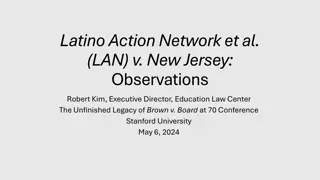
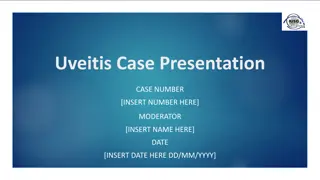
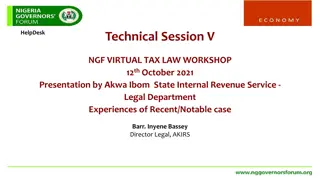
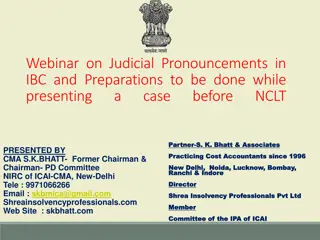





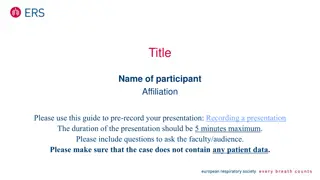
![Comprehensive Case Study on [Insert Case Title Here]](/thumb/159705/comprehensive-case-study-on-insert-case-title-here.jpg)




